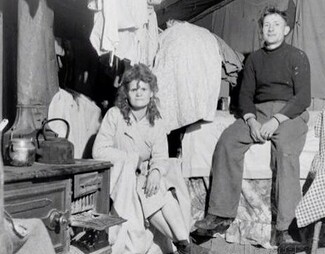Gypsies of the New Forest – by Ryalla Duffy

The New Forest is really the very old Forest, enclosed as a Royal hunting ground by William the Conqueror. Since ancient Saxon times, this open heathland and forest has run through the counties of Hampshire, Dorset and Wiltshire, until it finally met with the sea. Gypsies call the place 'Nevi Wesh' and have for centuries been drawn to its untamed beauty, fresh water springs, remote green places and abundant wild life.

Courts in Royal Stuart times over 400 years ago, periodically refer to the New Forest Gypsies and talk about the theft of timber and deer poaching. King Charles II’s mistress was a Forest Romany and under Royal Warrant was gifted three enclosures of Forest land.

Romany Gypsy Priscilla Wells lived and predominated as matriarch at Shave Green in the New Forest for many years of her life. The Wells were joined in the Forest by Lees, Stanleys, Burtons, Turners, Sherrards, Pidgleys, Willets, Does and other families. They eked a living on their wanderings by gathering and selling flowers, manufacturing beesoms, bee skeps and chair bottom caneing. At this time it was common practice for families to be allowed 48 hours grace unhindered, before being asked to move on. In fact, they were left undisturbed for much longer - an arrangement which suited Gypsies and Foresters alike. However, with the advent of the motor car, visitors from London began to invade the Forest. The nouveaux riche had little tolerance for the raggle-taggle Romanies that cluttered up the copses’’, and murmurs of dissent began.

By 1926 the Forest Commission had put the 'compound' system into place to corral the New Forest Gypsies into official enclosures. Seven such places were identified to which the unsuspecting Gypsies would be herded. Establishing compounds breached the New Forest Act of 1877 – but this was tactically disregarded by the authorities involved. Black Hamsley, Broomfield, Hardley, Latchmoor, Shave Green, Millersford and Thorney Hill were the locations chosen. Families were rounded up and herded onto these sites, along with their animals and impelled to remain there under threat of harsh fines. By the 1930's, Thorney Hil, numbered 400 residents at a time. To sit there now, in the silence and sunlight, its atmosphere seems to resonate with the voices and spirits of the families forced to make it their home.

After the war, in 1946, the New Forest Committee published a report that was to herald disastrous changes for the families. Once put in motion, it would prove impossible to stop. By the late 1950s over 600 Gypsies were living in the compounds, though no permanent structures were allowed, nor floors or windows. Despite the dilapidated appearance of these shacks, inside they were cosy, warm and dry. Outside however they frequently had no water, sanitation or refuse collection. In winter, overcrowding and mud created problems.

The draconian actions of the UK authorities were condemned by many. The Centre for Holocaust and Genocide Studies recognizes that: "It is hard to believe that civilized Britons would herd innocent people into compounds because of their race, just as Nazi Germans would a few decades later". Some that were forced into housing fared little better. As one old Romany lamented "When freedom is taken away, the life of the flower shall wither and non but those weeping shall be found on the face of the Earth. A people without a miracle - in a sea of mud".

By the middle of the 1960s most of the families had been removed, although stubborn stragglers hung on until the 1970s. Juanita Casey, speaking on behalf of the authorities- observed: "Like an unruly harvest, the Gypsies have been safely gathered in, to council houses".

Some families evaded the claws of the council, mustering the necessary finance to purchase their own small parcels of land, continuing their trade as horse dealers and flowers sellers. Similarly, in certain graveyards, a colourful, well-tended mismatch of colours signified the final resting place of Forest families, huddled away, in a straggled and unruly throng, in death, as in life, only on the fringe.

As the lopsided headstones lean into each other, as if in deep conversation, they are a silent visual reminder of that which the Romany Gypsy race represents: Independence, originality and close family values and support. The long disused compounds, the majestic beeches and holly thickets, once home to hundreds, have been swallowed back by the Forest from which they came. Yet for the old ones, the memory keepers, the discerning, the Forest will again yield her secret signs, her 'patrins', to those that know and seek.

Some children of the Forest stayed, others travelled further afield, to America and beyond. The pull of the Nevi Wesh is not easily shaken off though and pilgrims from near and far revisit the ancient camps and wild green stopping places, to commemorate the passages of life. Evidenced by wild posies, tributes, wilting on the moss, or a lone shaved chrysanthemum in the forest in winter, embedded in the frozen ground.


(c) Ryalla Duffy 2016.